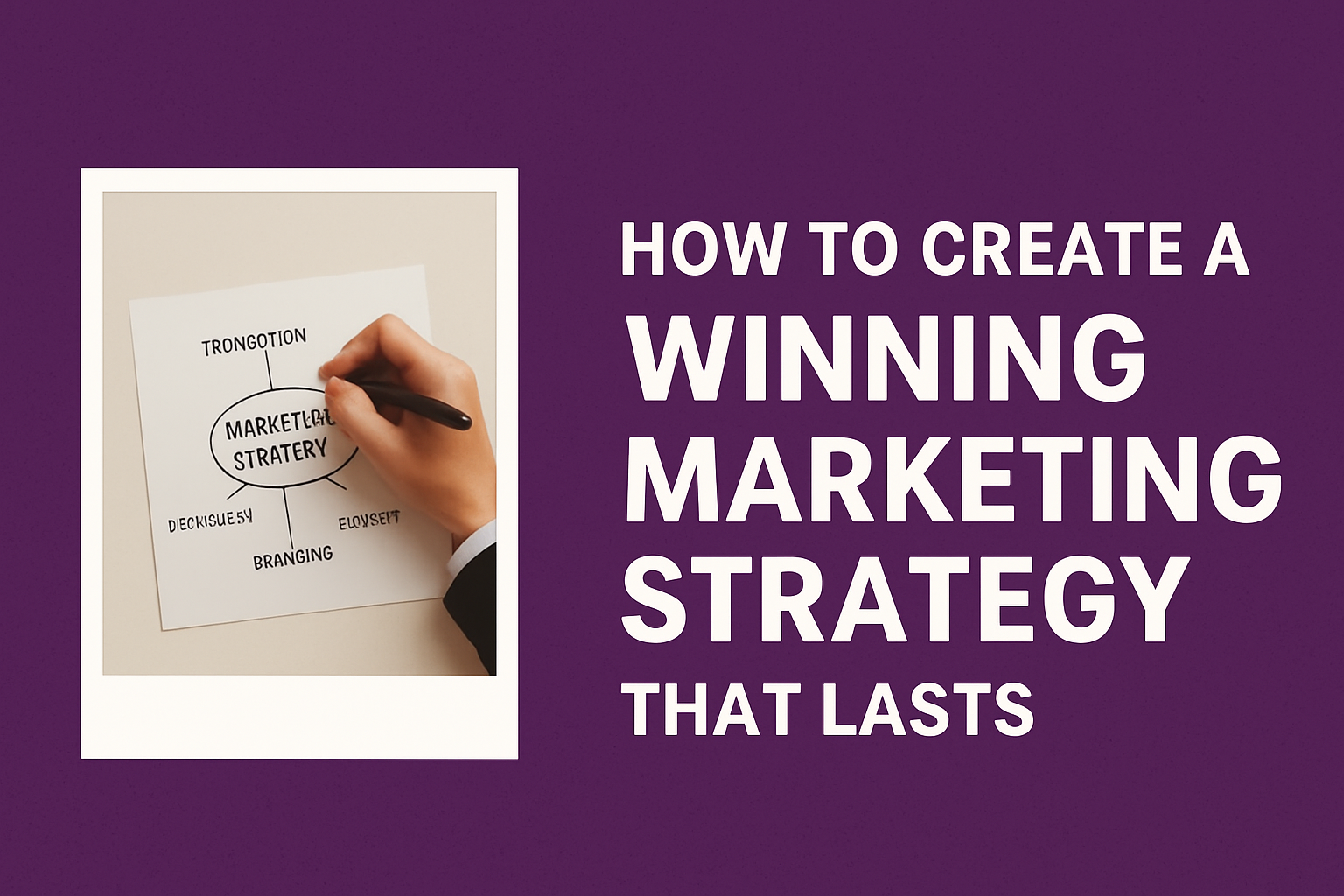Table of Contents
ToggleIntroduction
Marketing has evolved rapidly over the last decade. In today’s competitive landscape, businesses cannot rely on sporadic campaigns or generic advertising to succeed. Customers are more informed, digitally connected, and selective than ever.
A winning marketing strategy is no longer just about promotion — it’s about building relationships, delivering value, and creating a brand that stands the test of time. Long-term success requires a clear plan, consistent execution, and a deep understanding of your audience.
In this article, we’ll explore how businesses can create a marketing strategy that lasts, drives measurable results, and adapts to changing trends in 2025 and beyond.
1. Understand Your Audience Deeply
The foundation of any marketing strategy is a thorough understanding of your target audience. Businesses that know their customers’ preferences, behaviors, and pain points can craft messages that resonate and convert.
Start by creating detailed customer personas. Identify demographics, interests, challenges, and buying patterns. Use surveys, social media analytics, and sales data to gather insights.
Why understanding your audience matters:
-
Increases engagement with tailored content.
-
Helps prioritize marketing channels effectively.
-
Reduces wasted budget on irrelevant campaigns.
Marketing strategies that ignore audience insight often fail, no matter how creative or expensive they are.
2. Set Clear Goals and KPIs
A long-lasting marketing strategy requires clear objectives. Define what success looks like for your business — whether it’s increasing leads, boosting sales, or improving brand awareness.
Break down goals into measurable Key Performance Indicators (KPIs). These could include metrics like website traffic, email open rates, social media engagement, or conversion rates.
Tips for setting actionable goals:
-
Use the SMART framework: Specific, Measurable, Achievable, Relevant, Time-bound.
-
Align marketing goals with overall business objectives.
-
Regularly review and adjust KPIs based on performance.
Clear goals provide direction and make it easier to evaluate the effectiveness of your campaigns over time.
3. Build a Strong Brand Identity
Your brand identity is more than a logo — it’s the perception customers have of your business. A consistent, recognizable identity builds trust and loyalty, creating a lasting impression in the marketplace.
Focus on developing:
-
Visual identity: Logo, colors, typography, and design elements.
-
Brand voice: The tone and messaging style used across all communications.
-
Brand values: The principles that guide your business and resonate with your audience.
A cohesive brand identity ensures every marketing effort feels consistent and professional, strengthening recognition over time.
4. Leverage Multi-Channel Marketing
Successful businesses in 2025 utilize a multi-channel approach to reach customers wherever they are. From social media to email marketing, content marketing, and paid advertising, diversifying channels increases visibility and engagement.
While each channel has its own best practices, it’s important to maintain a consistent message across all touchpoints. This reinforces your brand and avoids confusing customers.
Effective multi-channel strategies:
-
Combine organic and paid campaigns to balance reach and ROI.
-
Use social media to engage and email to convert.
-
Monitor performance on each channel to allocate resources wisely.
A multi-channel presence ensures your brand stays top-of-mind and adapts to evolving customer behaviors.
5. Create High-Quality, Value-Driven Content
Content is the backbone of any modern marketing strategy. Customers are attracted to businesses that provide valuable, relevant information rather than just selling products.
Focus on creating content that educates, entertains, or solves problems for your audience. This can include blog posts, videos, podcasts, social media posts, and guides.
Benefits of high-quality content:
-
Builds authority and trust in your industry.
-
Improves SEO and organic visibility.
-
Generates leads and nurtures customer relationships.
Consistency is key — a brand that publishes valuable content regularly keeps its audience engaged and loyal over time.
6. Optimize for Search Engines (SEO)
SEO remains a crucial long-term marketing tactic. Businesses that optimize their websites for search engines attract organic traffic and reduce reliance on paid campaigns.
Start with keyword research, identifying terms your target audience searches for. Then, optimize website structure, meta tags, and content. Don’t forget local SEO if your business serves a specific area.
Simple SEO best practices:
-
Use relevant keywords naturally in content.
-
Improve website speed and mobile responsiveness.
-
Build backlinks through quality content and partnerships.
SEO is a marathon, not a sprint. Businesses that invest consistently in optimization see compounding results over time.
7. Use Data to Drive Decisions
Data-driven marketing allows businesses to make informed decisions rather than relying on guesswork. Analytics tools provide insights into customer behavior, campaign performance, and ROI.
By tracking metrics, you can identify which strategies are working and which need adjustment. Experimentation combined with data ensures continuous improvement.
Data-focused marketing tactics:
-
Analyze website traffic to understand audience interests.
-
Monitor social media engagement to refine messaging.
-
Track conversion rates to optimize sales funnels.
Smart businesses leverage data to refine strategies, increase efficiency, and ensure long-term success.8. Build Strong Customer Relationships
Marketing isn’t just about attracting new customers — it’s also about nurturing existing ones. Loyal customers are more likely to make repeat purchases and advocate for your brand.
Invest in relationship marketing through personalized emails, loyalty programs, and responsive customer support. Engaging customers on a deeper level strengthens your reputation and ensures longevity.
Ways to strengthen customer relationships:
-
Collect feedback and act on it promptly.
-
Offer personalized offers based on purchase history.
-
Maintain consistent communication through newsletters or social media.
A strong customer base acts as a foundation for sustainable growth and long-term marketing success.
9. Stay Agile and Adaptable
Markets change quickly, and a winning marketing strategy is flexible enough to adapt. Whether it’s adopting new platforms, responding to trends, or adjusting messaging, agility ensures your brand remains relevant.
Regularly review campaigns, analyze results, and implement improvements. The ability to pivot quickly gives businesses a competitive edge in an evolving landscape.
Tips for maintaining agility:
-
Test new strategies on a small scale before full implementation.
-
Stay updated on digital marketing trends and tools.
-
Encourage a culture of innovation and experimentation.
Flexibility allows businesses to turn challenges into opportunities rather than obstacles.
10. Plan for Long-Term Growth
A lasting marketing strategy balances immediate results with long-term goals. Short-term campaigns can generate leads and sales, but consistent planning ensures your brand continues to grow sustainably.
Set milestones, invest in scalable systems, and maintain a strong brand identity. By thinking beyond quarterly results, you can build a marketing foundation that withstands competition and market changes.
Future-proof strategies include investing in content libraries, automation, and ongoing audience research to keep your campaigns fresh and relevant.
Conclusion
Creating a marketing strategy that lasts requires a combination of planning, creativity, and adaptability. Understanding your audience, delivering value, leveraging multiple channels, and using data-driven insights forms the backbone of sustainable marketing.
In 2025 and beyond, businesses that prioritize long-term relationships, consistency, and innovation will outperform competitors relying solely on short-term tactics.
A winning marketing strategy isn’t just about campaigns — it’s about creating a strong, lasting connection with your audience. By implementing these principles, your business can grow steadily, maintain relevance, and achieve lasting success.


